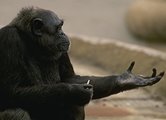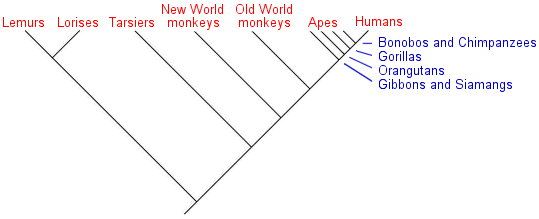|
|
|
|
Typical
human |
In addition to the great apes, the
family Hominidae
includes our species,
Homo sapiens
![]() .
In the past, there also were other species of humans as well as hominids
more similar to us than the chimpanzees and bonobos. They will be
described in the last three tutorials of this series.
.
In the past, there also were other species of humans as well as hominids
more similar to us than the chimpanzees and bonobos. They will be
described in the last three tutorials of this series.
It has been historically difficult for people to accept that we are in fact just another primate species with African origins and that we differ physically only in degree from some of the others. The similarities can be seen throughout our bodies. The African apes and humans have essentially the same arrangement of internal organs, share all of the same bones (though somewhat different in shape and size), lack external tails, and have several important blood type systems in common. We also get many of the same diseases. Humans and the African apes have hands with thumbs that are sufficiently separate from the other fingers to allow them to be opposable for precision grips. Like all of the great apes, humans are sexually dimorphic--human men are 5-10% larger on average and have greater upper body muscular development. Like chimpanzees and bonobos, we are omnivorous. We kill other animals for food in addition to eating a wide variety of plants.
 |
 |
|
| Similar chimpanzee and human hands | ||
 |
|
| Bipedal locomotion |
The comparatively minor anatomical differences between
humans and apes are largely a result of our habitual bipedalism
![]() .
A number of changes in our bodies were related to the
evolution of this form of locomotion. Unlike apes, our arms are
relatively short and weak compared to our legs. Our feet no longer have the ability
to effectively grasp and manipulate objects because the
toes became shorter and the big toe moved up into line with the
others. Human feet also have lengthened and acquired an arch, making them better
body supports. The human pelvis and spinal column also have been modified for an erect posture and
efficient bipedal locomotion.
The pelvis became shorter, broader, and more bowl shaped. This
provided greater stability for walking and running.
We are now essentially fully terrestrial animals. Nature
very likely selected for longer legs with powerful muscles and spring-like
tendons in humans because it is more
efficient for walking and especially running bipedally. Research done
by Herman Pontzer of Washington University in St. Louis, Missouri indicates
that longer legs require less up-and-down movement while running and,
therefore, reduce the amount of energy needed to move rapidly. This
relatively lower rate of energy consumption would also allow humans to travel
farther with the same calorie expenditure. In addition, the largely
hairless human body with its abundance of sweat glands allows us to remain
cooler while running than if we only relied on panting like most other
mammals. This no doubt was a major advantage for our early human
ancestors in the competition with other hunters and scavengers for meat in
warm climates. Humans can easily be outrun by many other animals over
short distances. However, we are endurance runners and can ultimately
run down virtually all other land animals.
.
A number of changes in our bodies were related to the
evolution of this form of locomotion. Unlike apes, our arms are
relatively short and weak compared to our legs. Our feet no longer have the ability
to effectively grasp and manipulate objects because the
toes became shorter and the big toe moved up into line with the
others. Human feet also have lengthened and acquired an arch, making them better
body supports. The human pelvis and spinal column also have been modified for an erect posture and
efficient bipedal locomotion.
The pelvis became shorter, broader, and more bowl shaped. This
provided greater stability for walking and running.
We are now essentially fully terrestrial animals. Nature
very likely selected for longer legs with powerful muscles and spring-like
tendons in humans because it is more
efficient for walking and especially running bipedally. Research done
by Herman Pontzer of Washington University in St. Louis, Missouri indicates
that longer legs require less up-and-down movement while running and,
therefore, reduce the amount of energy needed to move rapidly. This
relatively lower rate of energy consumption would also allow humans to travel
farther with the same calorie expenditure. In addition, the largely
hairless human body with its abundance of sweat glands allows us to remain
cooler while running than if we only relied on panting like most other
mammals. This no doubt was a major advantage for our early human
ancestors in the competition with other hunters and scavengers for meat in
warm climates. Humans can easily be outrun by many other animals over
short distances. However, we are endurance runners and can ultimately
run down virtually all other land animals.
A downside of the evolution of efficient bipedalism in humans is that it resulted in changes in the pelvis which unfortunately included a narrower birth canal in females. As a consequence, giving birth is a more difficult and riskier process for us than for most other mammal species. During delivery, human babies must partially rotate laterally twice during their passage through the oval birth canal in order for their comparatively large heads and then their broad shoulders to make it through. This is usually a long, tiring, and painful process for the mother as well as a risky one for her baby. Because of this, human mothers generally seek help from a "midwife" for the delivery. Other primates give birth without assistance. A partial evolutionary solution to this birth difficulty for humans was fetuses being born at a less mature stage, when their heads and torsos are smaller. The trade off is that human infants are more vulnerable. By comparison, chimpanzees at birth are neurologically and cognitively ahead of human babies of the same age, but the chimps begin to fall behind by about six months old because of the more rapid continued development of the human brain following birth.
With the exception of these differences, we are quite similar to the African apes anatomically and genetically, especially to the chimpanzees and bonobos. Humans have 46 chromosomes in their cells while all of the great apes have 48. In reality, this difference is not as great as it would initially seem because the human chromosome 2 is a fusion of ape chromosomes 12 and 13 with most of the same genes.
Human chromosome 2--video clip from Teachers' Domain
This link takes you to a new webpage. To return here, you must click the
"back" button on your browser program. (length = 3 mins 27 secs)
Research on learning the entire genome of common chimpanzees was completed in 2005. A comparison between this and the human genome (completed in 2001) shows that 96% of DNA base pair sequences of humans and chimpanzees are the same. Most of the 4% difference is in duplicated non-gene segments. If only gene segments are compared, there is a 98% similarity. The genes that differ mostly control speech, smelling, hearing, digesting proteins, and susceptibility to certain diseases. These dissimilarities are to be expected given that we have been on essentially separate evolutionary tracks for 6-7 million years. During that time, we have been subject to somewhat different natural selection pressures. These differences led to bipedalism for our ancestors along with a much larger brain and, ultimately, speech.
Comparing the Human and Chimpanzee Genomes This link takes you to
a new webpage. To return here, you must click the "back" button on your
browser program. (length = 1 mins 40 secs)
The modern human brain is 3 times larger in volume than those of the great apes. More importantly, the human brain to body size ratio is significantly larger, and it has a much bigger cerebral cortex with a higher concentration of neurons. Evolving a larger brain comes at a steep energy cost. The human brain uses about 25% of the energy derived from the nutrients that we consume and 20% of the oxygen. Recent research has suggested that our intelligence advantage may be due to evolutionary changes in the HAR1F regulator gene beginning about 6 million years ago in our pre-human ancestors but not in those of chimpanzees or other apes. This gene is involved in the production of brain tissue between the 7th and 19th week after conception. It is not surprising that there are some striking differences between the great apes and humans in mental abilities. People have much more complex forms of verbal communication than any other primate species. We are the only animal to create and use symbols as a means of communication. We also have more varied and complex social organizations. The most distinctive feature of humans is our mental ability to create new ideas and complex technologies. This has proven invaluable in the competition for survival. However, the great apes are also surprisingly intelligent, having mental levels equivalent to a 3-4 year old human child. This is sufficient to allow them to learn and use the sign language of deaf humans in at least a rudimentary way, but they do not have the capability of producing human speech and language. This is likely due to the fact that they have a different form of another key regulator gene known as FOXP2.
There is one additional curious difference between humans and all other primates that is worth noting. Older human females go through menopause and become sterile, often decades before dying of old age. Female chimpanzees, gorillas, and other non-human primates usually remain capable of conception and giving birth even when they are very old. In the wild, they live only a relatively short amount of time following menopause, if they go through it at all. One explanation for this difference in humans is that years of life following menopause has proven to have natural selection value for our species. Having raised their own children, post-menopausal women around the world often take care of their grandchildren while their daughters are working. It is argued that this increases the chances that the grandchildren will survive to adulthood because they receive this additional experienced and caring attention. Grandmothers helping daughters to raise their children also allows mothers to have additional babies before the older ones are mature enough to take care of themselves. All other primates normally do not give birth again before their current child no longer needs parental care.
Review of Ape and Human Classification
Apes and humans are members of the suborder Anthropoidea, the Infraorder Catarrhini, and the superfamily Hominoidea.
| ANTHROPOIDS: |
|
|||||||||||||||||
The gibbons are sufficiently different to be in their own family of hominoids, the Hylobatidae. Along with the Great apes, humans are members of the family Hominidae. Of all living species, people are genetically and evolutionarily closest to the African apes. Subsequently, we have been placed into the same subfamily, the Homininae.
|
HOMINOIDS: |
|
|||||||||||||||||||||||||||||||
Evolutionary Relationship of Primates
A comparison of DNA nucleotide sequences of living primate species show that humans are most closely related to the African apes. Next in descending order of genetic closeness to us come the Asian apes, Old World monkeys, New World monkeys, tarsiers, and finally the lemurs and lorises. This genetic comparison corresponds exactly with a comparison of homologous primate physical traits. It also fits nicely with what we know from the fossil record. The prosimians were the first to evolve. Next came the monkeys, then the apes, and finally humans.
| Cladogram
of primates based on homologous physical traits and genetic similarities |
 |
|
This link takes you to a new webpage. To return here, you must click the "back" button on your browser program. (length = 1 mins 47 secs) |
NOTE: A draft of the rhesus macaque monkey complete genome was completed in 2007. Comparing this genome with those already established for chimpanzees and modern humans will provide an even better tool for understanding the similarities and differences between the major groups of primates. Preliminary analysis indicates that macaques are similar to humans in 93% of their DNA sequences, while chimpanzees share about 96% of their DNA sequences with us. This somewhat lower percentage for macaques is to be expected because the last common ancestor of macaques and humans was about 19 million years ago, while the chimpanzees and human evolutionary lines diverged only around 6-7 million years ago. The U.S. National Human Genome Research Institute (NHGRI) has plans to sequence the genomes of marmosets, northern white-cheeked gibbons, orangutans, and gorillas.
The Macaque Genome--video clips from the Science Multimedia Center
This link takes you to 3 short videos at an external website.
(closed caption version)
